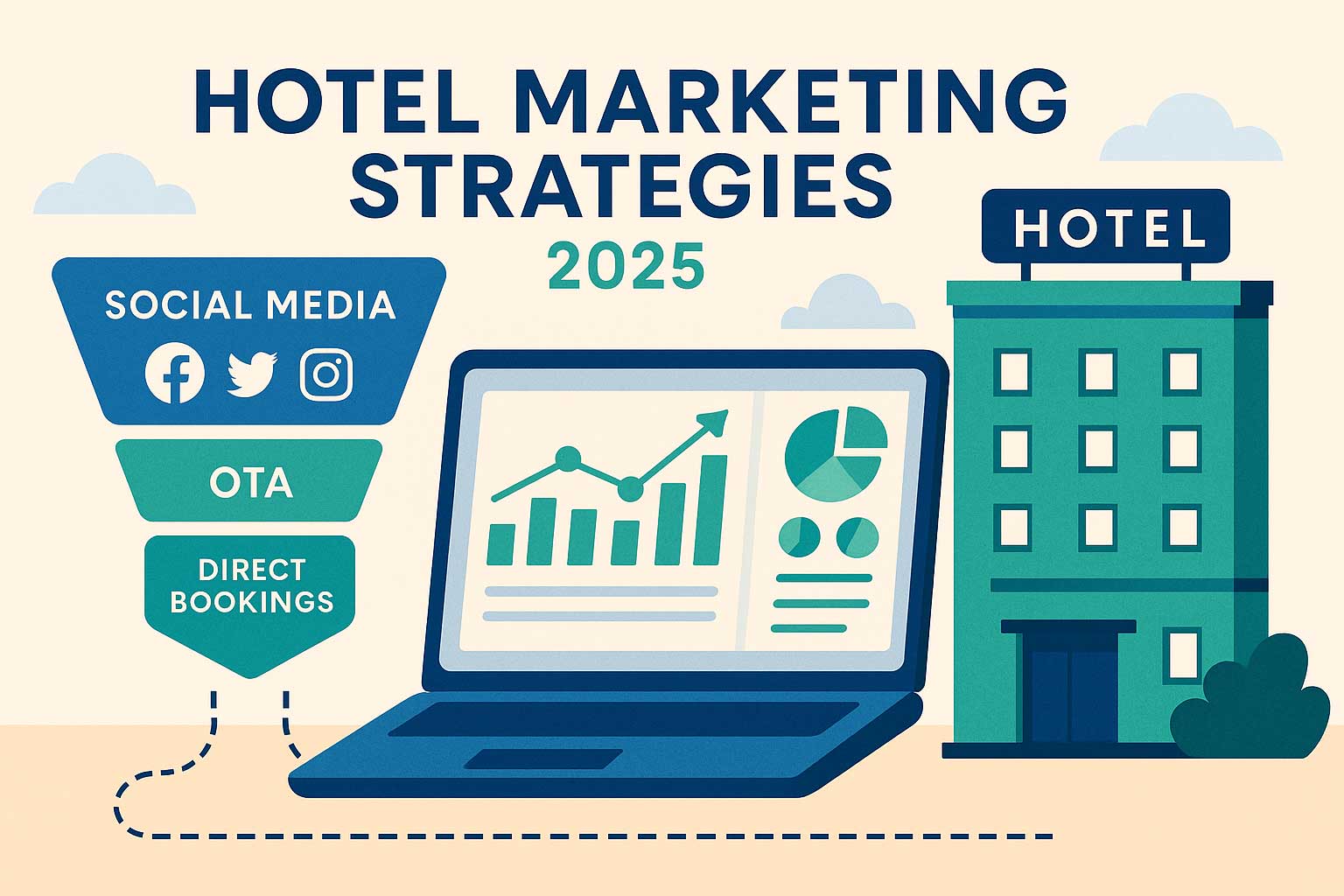15 Proven Hotel Revenue Management Strategies
Sep 8, 2025
 Mika Takahashi
Mika TakahashiPopular Categories
Hotel Technology & InnovationHotel Operations OptimizationDigital MarketingIndustry TrendsRevenue ManagementHospitality Industry
Popular Categories
Trending Post

Hotel Walk Letter Template: Professional Guest Communication

Online Travel Agents: What They Are and How They Work

Hotel Security Systems: Modern Protection Solutions

Hotel Advertising: Complete Guide to Boost Bookings and Revenue

25 Hotel Marketing Strategy Ideas for 2025: Complete Guide

AI Reservation Agent: Revolutionizing Hotel Booking and Guest Experience

PMS Communication: Streamlining Property Management Through Effective Guest Messaging
Table of contents
In today’s fast-paced hospitality world, what separates thriving hotels from those just getting by often boils down to one key skill: managing revenue effectively. Hotel revenue management has come a long way from the days of simply tweaking prices by season. Now, it’s a sophisticated, data-driven craft that can truly make or break a property’s bottom line.
The hotel industry has seen a major shift in how successful hotels handle pricing and inventory. Gone are the days when gut feelings and basic seasonal changes were enough. Today, it’s all about real-time analytics, predictive models, and smart distribution across multiple channels. Hotels that get a handle on these modern revenue management strategies consistently leave their competition in the dust.

This guide will walk you through 15 tried-and-true tactics that top hotels use to boost their profitability in 2025. From dynamic pricing algorithms to optimizing ancillary revenue, you’ll learn how to put strategies in place that can improve your property’s financial performance by 6-12% or even more.
What Are Hotel Revenue Management Strategies and Why They Matter
At its heart, hotel revenue management strategies is about using data to optimize pricing and inventory so you can maximize total revenue per available room. It’s about selling the right room, to the right guest, at the right time, for the right price, and through the right channel.
These strategies go way beyond just changing rates here and there. They combine pricing optimization, inventory controls, demand forecasting, and managing distribution channels to squeeze the highest revenue yield out of your available rooms.
The impact of effective hotel revenue management is huge. Big players like Marriott and Hilton consistently outperform their competitors by 15-25% thanks to smart revenue management that optimizes key performance indicators like RevPAR (Revenue per Available Room), ADR (Average Daily Rate), and occupancy rates.
Since the pandemic, the shift from fixed pricing to dynamic pricing strategies has become even more important. Changing travel patterns demand a nimble approach to pricing and inventory management. Hotels that adapted quickly to these new realities have held onto stronger financial performance during uncertain times.
Hotels with advanced revenue management strategies typically enjoy 6-12% higher profitability than those without. This edge comes from being able to capture top dollar during peak demand while staying competitive during slower periods. Plus, these modern strategies let hotels respond quickly to market changes, competitor pricing, and unexpected events that impact demand.
What really sets successful hotels apart is how they balance occupancy and room rates to maximize RevPAR. While some might fill rooms at bargain prices, others focus on strategic pricing and inventory control to maximize profit.
Dynamic Pricing and Rate Strategy Management
Dynamic pricing means adjusting your room rates in real time based on market demand, competitor pricing, and booking pace. This approach lets hotels capture the highest revenue during peak times while staying attractive during slower periods.
Real-Time Dynamic Pricing Implementation
To pull off real-time hotel dynamic pricing, properties need to tweak rates multiple times a day, keeping an eye on demand signals, competitor pricing, and booking pace. The best hotels don’t stick to static rates; instead, they adjust prices to reflect what’s happening in the market right now.
During big events like New Year’s Eve or the Super Bowl, hotels use rate fences and restrictions to charge premium prices while managing inventory carefully. This might mean setting minimum stays, advance purchase rules, or other booking restrictions that segment demand based on how sensitive guests are to price.
Take Comic-Con in San Diego, for example. Hotels close to the convention center often hike rates by 300-500% and enforce 4-7 night minimum stays with advance deposits. Planning these pricing strategies months ahead helps hotels sell out at top rates.
Art Basel Miami is another prime example. Hotels there adjust pricing to capture value from the international art crowd, often using dynamic pricing that ramps up rates as the event approaches.
Setting minimum and maximum rate limits protects your brand while maximizing revenue. Floor rates keep you profitable during slow times, while ceiling rates ensure you don’t alienate guests during peak demand.
Length of Stay Controls and Inventory Restrictions
Minimum stay requirements during busy periods help hotels capture more business on shoulder nights and boost overall revenue. For weekends, 2-3 night minimums are common, while holidays might call for 4-7 night restrictions to encourage longer stays.
Closed-to-arrival and closed-to-departure rules prevent guests from booking just part of a high-demand period, helping hotels maintain balanced occupancy. These controls make sure premium nights aren’t sold in isolation but as part of a package that includes less popular dates.
Using these controls to capture shoulder-night business around peak times can significantly lift revenue. Hotels near big events like Coachella, SXSW, or major sports games often use complex stay controls to maximize income and manage guest flow. They might block single-night stays but offer attractive multi-night packages at different rates.
Technology and Automation Strategies
Technology is a game-changer for hotel revenue management, streamlining processes and boosting decision-making with real-time data and automated recommendations. Modern revenue management systems (RMS) handle massive data sets to find optimal pricing strategies that would be impossible to manage manually.
Revenue Management System Integration
Top RMS platforms like Prostay, IDeaS, and Duetto cater to different hotel sizes and needs. IDeaS is popular with large hotel chains, Duetto offers user-friendly tools for mid-sized properties, and Atomize focuses on AI-driven pricing for independents and smaller chains.
Automated pricing recommendations can cut manual work by 60-80% while improving pricing accuracy. These systems analyze market data, booking trends, and competitor pricing continuously to suggest rates that revenue managers can implement quickly.
Integrating RMS with property management systems (PMS) like Prostay, Opera, Protel, or RoomMaster ensures smooth data flow between reservations, inventory, and pricing. This reduces manual entry and gives real-time updates so hotels can react fast to market shifts.
Hotels often see a 3-8% revenue boost within 6-12 months of adopting these systems. As staff get comfortable with advanced features and automation, results can be even better.
Investing in technology pays off with sharper pricing, lower labor costs, and faster responses to market opportunities. It frees up your team to focus on strategy instead of crunching numbers.

AI and Machine Learning Applications
AI takes forecasting to the next level by analyzing booking patterns, weather, and local events to predict demand with impressive accuracy. Machine learning sifts through historical and real-time data to spot trends that humans might miss.
These algorithms get smarter over time, improving forecast accuracy by learning from booking behavior and market changes. They help optimize pricing and inventory management dynamically.
AI-powered hotel chatbots create upselling opportunities during booking by suggesting room upgrades, dining packages, or extra services tailored to guest preferences and history, boosting ancillary revenue.
Hotels using AI for personalized pricing tailor rates based on guest history and preferences, offering customized deals that improve conversion rates. This means considering past stays, booking habits, and price sensitivity to optimize pricing for each guest.
AI in revenue management is evolving fast, and hotels investing in these tools are building a strong competitive edge through smarter, data-driven decisions.
Distribution Channel Management Strategies
Balancing direct bookings with third-party channels creates a revenue mix that maximizes profit while maintaining broad market reach. Smart distribution strategies weigh revenue potential against acquisition costs across all channels.
Optimizing Direct Booking Conversion
Best-rate guarantee programs help compete with OTAs by offering price matching plus extras like room upgrades, late checkout, or resort credits that OTAs don’t provide.
Optimizing your website for mobile, speeding up booking engines, and simplifying navigation reduce booking abandonment and boost direct bookings.
Integrating loyalty programs offers exclusive perks that encourage guests to book directly, with tiered benefits and personalized experiences that build loyalty.
SEO targeting local keywords like “hotels near [landmark]” or “[city] business hotels” helps capture organic search traffic from guests researching accommodations nearby.
Direct bookings not only save on commission fees but also provide valuable guest data for personalized marketing and service.
Third-Party Channel Strategy
Maintaining rate parity across OTAs like Booking.com, Expedia, and Agoda protects your brand and ensures consistent pricing.
Analyzing commission costs helps decide when to adjust OTA rates to keep profitability.
Advertising on metasearch platforms like Google Hotel Ads and TripAdvisor requires careful budgeting and bid management to compete with OTAs while controlling your direct booking experience.
Managing availability across channels during busy periods requires smart inventory controls to avoid overbooking and maximize revenue.
Treat OTAs as partners, leveraging their reach while protecting your direct booking relationships for a balanced distribution approach.
Guest Segmentation and Market Analysis
Different guest segments have unique price sensitivities and booking habits that call for tailored pricing and marketing. Understanding these differences lets hotels target the right segments with relevant offers and pricing.
Corporate and Group Revenue Optimization
Negotiating corporate rates involves balancing volume guarantees with rate integrity, including minimum stays and pickup percentages. Good contracts include escalation clauses and periodic reviews.
Managing group blocks with displacement analysis helps avoid turning away higher-paying transient guests during peak times by comparing potential revenue.
Targeting SMERF segments (Social, Military, Educational, Religious, Fraternal) requires rate structures that consider price sensitivity while providing appropriate services. These groups often book early and fill slower periods reliably.
Strong corporate partnerships with companies like IBM and Microsoft provide steady room night volume and long-term relationships through preferred rates and guaranteed availability.
Balancing immediate revenue with long-term partnerships creates sustainable revenue streams without sacrificing flexibility.

Leisure Market Segmentation
Family travelers respond well to packages that bundle breakfast, parking, or resort credits, increasing total spend and guest satisfaction.
Romantic getaway packages for occasions like Valentine’s Day or anniversaries command premium prices with extras like champagne, flowers, and spa treatments.
Adventure travelers appreciate local activity partnerships and extended stay discounts, seeking authentic experiences.
Seasonal leisure campaigns for summer vacations or winter holidays rely on early booking discounts, family deals, and special event programming.
Segmenting the leisure market lets hotels craft targeted marketing and pricing that resonate with specific guest types, boosting conversion and loyalty.
Forecasting and Data Analysis Strategies
Accurate forecasting underpins all revenue management decisions and budgeting by predicting future demand patterns. Combining multiple data sources and analytical methods yields the best projections.
Demand Forecasting Methodologies
Analyzing historical data over 1-3 years helps spot seasonal trends and recurring demand patterns, while accounting for unusual events.
Tracking local events, conferences, and festivals allows hotels to factor in their impact on demand.
Weather analysis is crucial for resorts and leisure properties where conditions affect bookings.
Monitoring booking pace helps identify when demand is building faster or slower than usual, enabling timely pricing adjustments.
Refining and validating forecasting models continuously leads to better pricing and budget planning.
Competitive Benchmarking
Choosing a competitive set of 4-6 similar hotels provides meaningful data for market positioning.
Rate shopping tools automate daily competitor price monitoring across channels and dates.
Market share analysis using STR reports helps interpret RevPAR index performance against market averages.
Quickly responding to competitor rate changes within hours requires automated monitoring and clear decision protocols.
Competitive benchmarking gives the context needed for smart pricing decisions and market positioning.
Ancillary Revenue Optimization
Non-room revenue can make up 30-50% of total hotel revenue, so optimizing ancillary income is key for profitability. These streams often have higher margins and boost guest satisfaction.
Food and Beverage Revenue Strategies
Upselling dining packages during booking and pre-arrival communication increases F&B revenue and guest convenience.
Special holiday dining packages command premium prices and predictable revenue while reducing marketing costs.
Room service optimization targets extended-stay and business guests with mobile ordering and specialized menus.
Partnering with local food delivery or restaurants creates commission income and expands guest dining options.
Coordinating pricing strategies between operations and revenue management maximizes total revenue.
Experience and Service Monetization
Wellness packages with seasonal treatments and bundles attract guests seeking relaxation, increasing length of stay and spend.
Dynamic parking pricing based on events and demand captures extra revenue in urban areas.
Pet-friendly services like beds, treats, and walking appeal to pet owners and differentiate the hotel.
Meeting and event spaces generate revenue through flexible pricing and comprehensive packages.
Creative monetization of guest needs builds multiple revenue streams and guest loyalty.

Performance Monitoring and KPI Management
Tracking essential metrics shows how well your revenue management strategies are working and highlights areas to improve.
Core Revenue Metrics
RevPAR combines occupancy and rate to measure revenue productivity and benchmark performance.
ADR tracks rate trends to ensure price optimization doesn’t hurt occupancy.
GOPPAR includes operating costs to measure true profitability.
TRevPAR adds ancillary income for a full picture of revenue impact.
Monitoring these metrics helps hotels make data-driven decisions that improve financial results.
Operational Performance Indicators
Booking pace shows demand strength by comparing current bookings to historical trends.
Tracking cancellations and no-shows helps optimize overbooking strategies.
Guest satisfaction scores link service quality with pricing power and repeat business.
Staff productivity metrics like revenue per employee measure efficiency.
These indicators balance revenue goals with operational excellence.
Implementation Best Practices and Training
Putting new strategies into practice requires planning, training, and ongoing support.
Staff Training and Development
Certification programs from HSMAI, Cornell, and STR build team expertise.
Cross-training front desk staff on upselling and rate communication ensures consistent guest interactions.
Monthly revenue meetings keep departments aligned on strategy.
Incentive programs motivate staff to meet revenue targets.
Investing in training builds a foundation for long-term success.
Technology Integration Timeline
A 90-day plan covers system setup, data migration, training, and monitoring.
Maintaining operations and data integrity during migration is critical.
Ongoing training and change management support smooth adoption.
Measuring success after 6 months and 1 year identifies areas for improvement.
Careful project management ensures a smooth tech transition.

Key Takeaways
In 2025, hotel revenue management strategies must blend technology, data analysis, and smart thinking to maximize profits. Properties that combine these 15 proven tactics consistently outperform their competition and build lasting advantages.
The best results come from integrating multiple strategies—dynamic pricing, distribution management, guest segmentation, and ancillary revenue optimization—into a cohesive revenue program.
Technology and automation enable hotels to tackle complex revenue challenges that manual methods can’t handle. AI, revenue management software, and automated reporting give hotels the tools to compete in today’s market.
Training and development remain vital. Hotels that invest in their teams see better results and build strong organizational capabilities.
The hospitality industry keeps evolving, so continuous improvement and innovation are key to staying competitive and profitable.
Start by focusing on the strategies that fit your property and market. Measure results, then expand your program as you gain confidence and see success.
Investing in a comprehensive revenue management approach pays off with higher profits, stronger market position, and happier guests. Commit to these tactics, and you’ll see real improvements in your hotel’s financial health and competitiveness.
